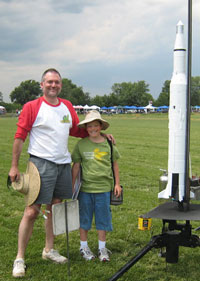- Posts: 14
- Thank you received: 0
Of Ring Tails and Tube Fins
- houston47d
-
 Topic Author
Topic Author
- Offline
- New Member
-

Less
More
13 years 4 months ago #4822
by houston47d
Of Ring Tails and Tube Fins was created by houston47d
Hello,
I have heard that tube fins create a lot of drag (and thus can be used to keep rockets from going too high). I presume the same is true of a ring tail.
In RockSim, I have a model I wanted to add a decorative ring tail too. It has three fins that extend out beyond the ring tail, so the ring tail in RockSim is setup for no pylons. Simply adding the ring tail (no change to the fins/pylons) causes the altitude projections to drop by more than half! Is this consistent with peoples\' experience using ring tails?
In addition, the ring tails contribution to the stability is not intuitive - as the ring tail gets longer, it reduces the stability as if the weight of the ring tail is moving the CG more than the CP is moving. And even when it gets really short (1/4\"), it shows it as having a significant contribution to the stability. Is there a reference somewhere that describes the aerodynamic effects of a ring tail?
I think I\'m going to do the design in RockSim without the ring tail, but build it with it.
Thanks,
David
I have heard that tube fins create a lot of drag (and thus can be used to keep rockets from going too high). I presume the same is true of a ring tail.
In RockSim, I have a model I wanted to add a decorative ring tail too. It has three fins that extend out beyond the ring tail, so the ring tail in RockSim is setup for no pylons. Simply adding the ring tail (no change to the fins/pylons) causes the altitude projections to drop by more than half! Is this consistent with peoples\' experience using ring tails?
In addition, the ring tails contribution to the stability is not intuitive - as the ring tail gets longer, it reduces the stability as if the weight of the ring tail is moving the CG more than the CP is moving. And even when it gets really short (1/4\"), it shows it as having a significant contribution to the stability. Is there a reference somewhere that describes the aerodynamic effects of a ring tail?
I think I\'m going to do the design in RockSim without the ring tail, but build it with it.
Thanks,
David
Please Log in or Create an account to join the conversation.
- Boris Katan
-

- Offline
- Elite Member
-

Less
More
- Posts: 230
- Thank you received: 6
13 years 4 months ago #4823
by Boris Katan
Replied by Boris Katan on topic Re:Of Ring Tails and Tube Fins
David,
My limited experience with tube fins is that they seem to scrub off roughly 1/3 of the altitude that would have been achieved with straight fins.
I too have seen that Rocksim modeling seems to have trouble with tube and ring fins, including the impossible results you describe.
If the rocket models and / or flies stably with the straight fins only, then adding a ring or tubes will only make it more stable.
I suppose you could try to model the rocket with straight fins that have nearly the total area that would be present with the actual straight plus ring fins. A rocket with an actual CG well in front of any fins is likely to be quite stable.
One thing to watch out for is turbulence near the rocket\'s body. As a rocket picks up speed there is an area of turbulence near the base of the rocket. The area of the fins that is very close to the rocket body no longer is exposed to a smooth fast flow of air and no longer contributes to stability.
What this means in practical terms is that a ring that is very close to the rocket\'s body should not be counted on to consistently stability. In this case the straight fins need to be big enough to get the job done.
If the ring fin diameter is 2x or more of the rocket\'s body diameter then it is more likely to consistently contribute to stability.
There was a very good two part article in Sport Rocketry one or two years ago dealing with tube fins. Key point from the article: When the rocket had tube fins small enough to fit 8 around the rocket body (ex: 3\" tube fins with 4\" body) there was almost no altitude loss compared to straight fins because much of the tube fin surface was in the turbulent area. These were generally short, fat rockets.
My limited experience with tube fins is that they seem to scrub off roughly 1/3 of the altitude that would have been achieved with straight fins.
I too have seen that Rocksim modeling seems to have trouble with tube and ring fins, including the impossible results you describe.
If the rocket models and / or flies stably with the straight fins only, then adding a ring or tubes will only make it more stable.
I suppose you could try to model the rocket with straight fins that have nearly the total area that would be present with the actual straight plus ring fins. A rocket with an actual CG well in front of any fins is likely to be quite stable.
One thing to watch out for is turbulence near the rocket\'s body. As a rocket picks up speed there is an area of turbulence near the base of the rocket. The area of the fins that is very close to the rocket body no longer is exposed to a smooth fast flow of air and no longer contributes to stability.
What this means in practical terms is that a ring that is very close to the rocket\'s body should not be counted on to consistently stability. In this case the straight fins need to be big enough to get the job done.
If the ring fin diameter is 2x or more of the rocket\'s body diameter then it is more likely to consistently contribute to stability.
There was a very good two part article in Sport Rocketry one or two years ago dealing with tube fins. Key point from the article: When the rocket had tube fins small enough to fit 8 around the rocket body (ex: 3\" tube fins with 4\" body) there was almost no altitude loss compared to straight fins because much of the tube fin surface was in the turbulent area. These were generally short, fat rockets.
Please Log in or Create an account to join the conversation.
